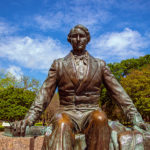When a racial justice coalition that grew out of Cliff Temple Baptist Church in Dallas discussed tangible ways to build bridges in its community, members decided to help their neighbors connect to past generations.

Volunteers from Cliff Temple worked with the Tenth Street Residential Association and others to clear away brush and bramble from overgrown graves in the long-neglected Black section of the segregated Oak Cliff Cemetery.
Members of Cliff Temple were instrumental in forming the Oak Cliff Justice Coalition as a direct result of the racial reckoning that followed the killing of George Floyd, Ahmaud Arbery and Breonna Taylor in 2020.
Cliff Temple’s teaching pastor and minister to young adults, Trevor Jamieson, invited church member Larry Johnson to join a Zoom meeting of the coalition to talk about the history and significance of the Tenth Street neighborhood in Oak Cliff.
Historically significant area
Johnson explained the Tenth Street neighborhood developed as a Freedman’s Town settled by formerly enslaved African Americans in the 19th century. At one time, it was home to Black doctors, lawyers and teachers.
“If you look at it now, it’s a place that’s a symbol of Black flight and redlining,” Johnson said in a later interview. African Americans left parts of the city where they were not welcome to purchase homes in the neighborhood, which now is almost exclusively African American and Hispanic.

When Interstate 35 was built in the mid-20th century, dozens of houses in the historic area were bulldozed, and a 2010 ordinance that allowed the city to demolish neglected historic structures smaller than 3,000 square feet led to more home demolitions.
In 2019, the National Trust for Historic Preservation named the neighborhood as one of the nation’s most endangered places.
Working with the Tenth Street Historic District and the Tenth Street Residential Association, Johnson became involved in efforts to preserve the neighborhood’s historic character. Among the area’s notable features is Oak Cliff Cemetery, believed to be the oldest public cemetery in Dallas County.
Sign up for our weekly edition and get all our headlines in your inbox on Thursdays
In his presentation to the Oak Cliff Justice Coalition, Johnson noted the crepe myrtles that bloom in the fairly well-maintained white section of the segregated cemetery, while the African-American section was overgrown with invasive privet and weeds.
During the Zoom call with the coalition, a member of Cliff Temple—Stan Granberry, who works with Texas Baptists’ GC2 Press—asked what kind of hands-on project could be completed to help Johnson’s efforts in the Tenth Street neighborhood.
“I threw out the crazy idea of cemetery work,” said Kenny Cheshier, executive pastor at Cliff Temple. “It took on a life of its own.”
Johnson, Jamieson, Cheshier and other members of Cliff Temple led in organizing a series of Saturday workdays at the cemetery.
‘Memorial to Black resiliency’

“We put it out on social media,” Jamieson said. He noted an ethnically and politically diverse group of volunteers from throughout the community joined members of Cliff Temple in working each Saturday for several months at the cemetery, eager to help restore a “memorial to Black resiliency.”
Johnson noted the Black section of the cemetery is unusually hilly, and that seems reflective of Black history in the United States.
“The terrain is typical of the African American experience in this country—rocky, full of hills to climb and difficult at times,” Johnson said.
When the volunteers began working last year, at least 90 percent of the headstones in the Black section of the cemetery were covered and inaccessible, Johnson said.
Granberry noted one of the previously obscured graves belonged to A.W. Moss, a former pastor of Griggs Chapel Missionary Baptist Church east of Fair Park in Dallas. Others belonged to relatives of Tenth Street Neighborhood residents who haven’t been able to visit the gravesites in decades.
‘Righting a wrong that was due to neglect’

“We were righting a wrong that was due to neglect,” Johnson said.
Next, Johnson hopes to secure donated gravel from the Texas Department of Transportation to pave a dirt road into the Black section of the cemetery and restore the grade on the cemetery’s perimeter to prevent further erosion and possible disruption of burial sites.
In the long term, Johnson dreams of seeing Tenth Street become a destination site for people interested in Black history.
“We’d like to give not only the city of Dallas, but also the state of Texas and all of the United States a preserved Freedman’s Town—an African American district comparable to Colonial Williamsburg,” he said.
“There’s a growing curiosity about African American history, but up until now, it’s a story that either has not been told or that has been under-told.”
In the meantime, Cliff Temple looks forward to continuing to work with Johnson on community projects in the Tenth Street neighborhood, Cheshier said.
“It’s been an incredible journey,” he said. “And there’s more to come.”














We seek to connect God’s story and God’s people around the world. To learn more about God’s story, click here.
Send comments and feedback to Eric Black, our editor. For comments to be published, please specify “letter to the editor.” Maximum length for publication is 300 words.